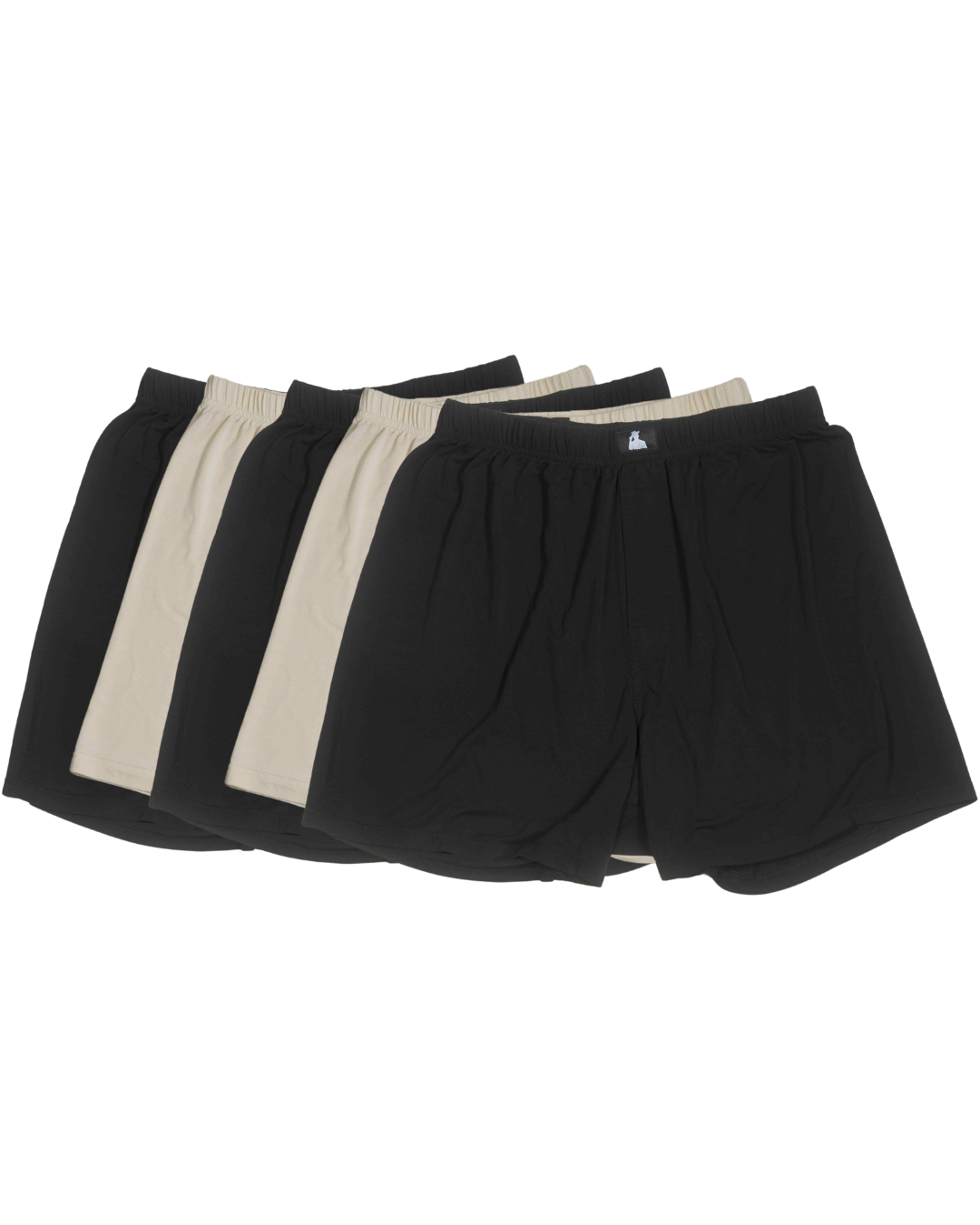What Type of Underwear Should Men Wear For Good Sperm?
Written By The Mr. Fertyl Research & Education Team
Most men don’t give a second thought to their underwear’s impact on fertility. Yet if you and your partner are trying to conceive, it turns out that what you’re wearing down there can make a difference. In this post, we’ll explore how different types of men’s underwear might affect sperm health. We’ll break down the science of heat and sperm production, compare boxers vs. briefs (and boxer briefs), and discuss why breathable, non-toxic materials are important. Along the way, we’ll also highlight how choosing fertility-friendly options – like Mr. Fertyl’s bamboo underwear – can help keep things cool and comfortable for healthier sperm.
How Underwear Can Affect Sperm Health
Male fertility is strongly influenced by the environment in which sperm are produced. The testicles hang outside the body in the scrotum for a reason: they need to stay a few degrees cooler than core body temperature for optimal sperm production [1]. Elevated heat in the scrotal area can impair spermatogenesis (the making of sperm). In fact, spending time in hot tubs or saunas can significantly reduce sperm count and motility for weeks afterward, until the sperm supply regenerates [1][2]. Everyday habits can contribute to excess warmth as well – including something as simple as the underwear you choose.
Tight, snug underwear holds the testicles closer to the body and can raise testicular temperature, whereas looser styles allow more air circulation and cooling [1][6]. The concern is that “heat is not kind to sperm,” as Cleveland Clinic urologist Dr. Raevti Bole puts it [2]. Even a slight, prolonged increase in scrotal temperature may negatively affect sperm count, motility, and DNA integrity. Over time, warmer testicles signal the brain to compensate by altering hormones, which could be a sign the body is struggling to maintain normal sperm production [6].
On the other hand, keeping things cool helps sperm thrive. Research suggests that the scrotum functions best around 2–7°C lower than normal body temperature, and exceeding that range can lead to “genital heat stress,” impairing sperm output and quality. This is why many fertility specialists advise men to make simple lifestyle changes to avoid unnecessary heat “down there” – for example, by switching to cooler underwear, taking breaks from sitting, and avoiding laptops on the lap or hot baths when trying to conceive [2][7]. It’s an easy adjustment that could protect your fertility.

Cool, breathable, and built for better swimmers.
Shop Mr. FertylBoxers vs. Briefs vs. Boxer Briefs: Which Is Better?
Looser styles like boxers allow for more airflow and lower heat retention, which can benefit sperm production.
For decades, the classic question has been “boxers or briefs?” When it comes to sperm health, science leans toward boxers. A large Harvard-led study of 656 men in 2018 found that those who usually wore boxer shorts had significantly higher sperm counts than men who wore tight-fitting briefs or jockeys [10]. On average, the boxer-wearers had a 25% higher sperm concentration and a higher total sperm count [10]. They also boasted more motile sperm – one report noted about 33% more swimming sperm per ejaculate in the loose boxer group compared to the tight underwear group [6]. These are meaningful differences that could tilt the odds in favor of successful fertilization.
Why the gap? The likely explanation is temperature. In the same study, men in tighter underwear had higher levels of follicle-stimulating hormone (FSH), a hormone that ramps up sperm production when the body senses the testes aren’t producing enough [10]. Lower sperm counts accompanied by elevated FSH in the tight-underwear group suggests the brain was in overdrive, trying to kickstart sperm output to overcome a heat-related slowdown [10]. In contrast, the boxer-wearing men, with cooler testicles, had normal FSH levels – their bodies didn’t have to work as hard to produce adequate sperm [10].
It’s important to note that both groups in the study still had average sperm counts in the normal range [6]. Wearing briefs won’t instantly make you infertile – so you shouldn’t panic if tighty-whities are your go-to. In fact, some health professionals argue the “boxers vs. briefs” debate is overstated. As Mayo Clinic experts point out, while briefs can raise scrotal temperature slightly, there’s no definitive evidence that this small difference translates to infertility in the real world [1]. A large preconception study of 500+ couples found no significant impact of underwear choice on actual time-to-pregnancy or overall fertility outcomes [4]. And Dr. Bole of Cleveland Clinic has noted that standard underwear style “doesn’t make a difference” in most cases of male fertility [2].
So, what’s the bottom line? For an otherwise healthy man, switching from briefs to boxers alone won’t guarantee a pregnancy. However, if you’re facing fertility challenges or just want to optimize your sperm health, wearing looser, cooler underwear is a simple step with potential upside [10]. Think of it as removing a possible roadblock: it may help, and it certainly won’t hurt. Boxer shorts maximize air circulation and keep testicles away from body heat, which is ideal for sperm production. Many men find boxers comfortable for daily wear, though some prefer more support during exercise or work. Boxer briefs can be a middle ground – they offer more support and coverage, but depending on their tightness, they might still increase warmth somewhat. If you opt for boxer briefs, consider ones with a relaxed fit or ultra-breathable fabric to minimize heat retention. The key is to avoid excessive compression and overheating. In fact, one study even observed that men who normally wore briefs improved several semen parameters when they switched to looser boxers (or went commando) at nighttime. Letting it all breathe while you sleep or whenever feasible can further ensure your swimmers stay cool and happy!
Materials Matter: The Role of Fabric and Toxic Exposure
Style isn’t the only factor – the material of your underwear also plays a critical role in sperm-friendly wear. Not all fabrics are created equal when it comes to breathability and safety. Cotton has long been the gold standard for undergarments because it’s natural, breathable, and allows moisture to evaporate. A cotton brief will generally trap less heat and humidity than a polyester or nylon brief. Synthetic fabrics like polyester, nylon, and other petrochemical-based textiles tend to insulate more and wick less, creating a warmer microclimate around the groin. They can also cause more sweat to accumulate, leading to discomfort (and even skin irritation or fungal issues). From a fertility perspective, staying cool and dry is key. A sweat-soaked synthetic pair of briefs on a hot day could raise scrotal temperature more than a dry, airy cotton pair of boxers.
There’s some striking (and cautionary) science about synthetic underwear. In a unique experiment, researchers found that polyester underwear had a harmful effect on sperm production in animal models. In one study, dogs made to wear polyester slacks for 24 months showed a significant decrease in sperm count and motility, and an increase in abnormal sperm forms [5]. Meanwhile, dogs wearing loose cotton underpants or nothing at all maintained normal sperm parameters [5]. After the polyester was removed, the affected dogs’ fertility gradually recovered, indicating the effect was reversible [5]. The cause wasn’t even a temperature change – intriguingly, the researchers speculated that electrostatic charges from the polyester fabric might have impaired spermatogenesis [5]. In humans, there was even an (admittedly extreme) trial in the 1970s investigating polyester underwear as a form of male contraception, due to its sperm-suppressing impact [5]. While you’re not a lab dog or a test subject, the takeaway is that breathable, natural materials are far safer for your swimmers than synthetics.
Beyond heat, “potentially harmful materials” refers to chemical exposures as well. Synthetic textiles are essentially plastics, and they may contain additives like dyes, finishing agents, or microplastic fibers. We’re still learning how these substances affect human health, but hormone-disrupting chemicals (like certain plastics and pesticides) have been linked to fertility problems [2]. It’s reasonable to avoid constant contact between your reproductive organs and synthetic chemicals whenever possible. Choosing underwear made from organic or natural fibers can minimize exposure to harsh dyes or treatments. Also, washing new underwear before the first wear is a good practice to remove any residual chemicals from manufacturing.
So, what fabrics are best? We’ve mentioned cotton as a reliable choice. Another excellent option is bamboo-derived fabric, which is used in Mr. Fertyl’s underwear line. Bamboo fabric is incredibly soft, breathable, and moisture-wicking [11]. This means it helps keep the area cool and sweat-free, much like cotton or even better. Bamboo fabric also contains a natural antimicrobial bio-agent (sometimes called “bamboo kun”) that gives it antibacterial and antifungal properties [8]. In other words, bamboo underwear can stay fresher and more hygienic, reducing the risk of irritation or odors. And as a bonus, bamboo is a sustainable, eco-friendly material – perfect for health-conscious men who care about the environment. Mr. Fertyl’s bamboo underwear combines all these benefits: a non-toxic, chemical-free fabric that lets your skin breathe and your testicles stay at an ideal temperature. It’s specifically designed with fertility in mind, so you don’t have to compromise between comfort, quality, and your reproductive health.
Tips for Choosing Sperm-Friendly Underwear
Making a few smart swaps in your underwear drawer can support better sperm health. Here are some evidence-based tips for fertility-friendly underwear choices:
- Go for Looser Fits: When possible, wear boxers or loose-fitting boxer briefs to allow air circulation. Tight underwear isn’t a death sentence for sperm, but looser styles help keep the testicles cooler [6][10]. Even just switching to boxers in the evenings or at home can be beneficial. Some men even choose to sleep without underwear – and research has noted improved semen parameters in men who wear nothing or boxers at night compared to those who sleep in briefs.
- Choose Breathable, Natural Fabrics: Prioritize materials like bamboo that are breathable and moisture-wicking. These fabrics will keep the groin area drier and cooler. Natural fibers also tend to be free of harmful chemical finishes. In contrast, avoid long-term use of tight synthetics (polyester, nylon, spandex blends) especially in hot conditions. They can trap heat and might expose your skin to unwanted chemicals or static charges that sperm won’t appreciate [5].
- Stay Cool During Work and Exercise: If you have a job that involves sitting for extended periods or physical activity, plan for temperature control. For example, if you cycle or jog (activities that often involve tighter athletic wear), consider changing into looser, cooler underwear soon after to let things cool down. At work, if you must wear snug underwear under formal attire, make sure the fabric is lightweight and breathable (e.g., a bamboo brief that supports but doesn’t overly constrict). Little changes like standing up periodically to cool off or adjusting your seating can help; pressure and heat from sitting too long can raise scrotal temps.
- Avoid External Heat Exposures: Remember that underwear is just one piece of the puzzle. Don’t counteract your smart wardrobe choices with other heat sources. Skip the hot tubs, jacuzzis, and sauna sessions while you’re trying to conceive [1]. Limit placing hot laptops or devices on your lap, and even be mindful of car seat heaters or hot environments. Keeping your general environment cool and comfortable will complement the effects of your breathable underwear.
- Watch Out for Toxins: Wash new underwear before wearing to eliminate any chemical residues. If possible, buy from brands that use dye-free or eco-friendly manufacturing, especially if you have sensitive skin. Some men opt for underwear labeled “Oeko-Tex certified,” which ensures the fabric has been tested for harmful substances. Overall, minimize direct contact between your groin and any strong chemicals – that includes avoiding heavily perfumed detergents on your underwear and steering clear of powders or products in that area unless recommended by a doctor. As the Cleveland Clinic notes, the modern decline in male fertility is often attributed partly to environmental toxins and hormone-disrupting chemicals in everyday products [2]. Every bit of reduction in exposure helps.
- Don’t Obsess Over Testosterone Myths: You might have heard that keeping your testicles cooler could boost testosterone or that some special underwear can increase testosterone levels. In reality, testosterone and fertility are related but not the same thing. Healthy sperm production does require normal testosterone, but simply changing underwear isn’t likely to make a meaningful dent in hormone levels. More importantly, chasing high testosterone isn’t the goal when you want good sperm—just ask your doctor. In fact, taking external testosterone (like supplements or injections) can wreck your fertility by shutting down your body’s sperm production [2]. So, focus on habits that directly help your sperm (like reducing heat and avoiding toxins) rather than gimmicks to “boost T.” Our approach to male fertility is all about nurturing sperm health naturally, not hyping hormones.

Comfort that supports your future.
Upgrade Underwear TodayConclusion: Keeping It Cool for Healthy Sperm
When it comes to male fertility, the devil is in the details – and yes, that includes your underwear drawer. The best type of underwear for good sperm is one that keeps your testicles cool, supported but not constricted, and free from harmful materials. Scientific evidence suggests that looser-fitting underwear (like boxers) made from breathable fabrics (like cotton or bamboo) provide a more sperm-friendly environment than tight, synthetic undergarments [5][10]. By preventing excess heat buildup and reducing contact with potential toxins, you’re giving your sperm the comfort they need to be plentiful and motile.
Remember, switching to sperm-friendly underwear won’t solve all fertility issues overnight – but it’s a simple, cost-free change you can control as part of a bigger plan for reproductive health [10]. Think of it as one piece of the fertility puzzle, alongside other smart habits like good nutrition, maintaining a healthy weight, managing stress, and avoiding smoking or heavy alcohol. All these factors together contribute to optimal sperm quality.
The great news is that talking about men’s fertility and underwear choice is becoming more normalized. There’s no shame in prioritizing your reproductive health – it’s actually a wise, proactive move. By choosing underwear that is supportive of your fertility (literally and figuratively), you’re taking agency over something that was once chalked up to fate. And you don’t have to sacrifice style or comfort in the process. Products like Mr. Fertyl’s premium bamboo underwear are designed for the modern man who cares about both his well-being and the planet. They offer a trifecta of benefits: cooler temperatures, natural materials, and eco-conscious quality. In other words, you get peace of mind that you’re doing right by your sperm while enjoying soft, high-quality undies – truly a win-win.
In summary, the best underwear for sperm health is cool, breathable, and non-restrictive. Give those swimmers some room to breathe and a toxin-free home. Your future family might thank you for it. And if you’re looking for an easy place to start, consider giving Mr. Fertyl’s bamboo underwear a try – your body and the environment will thank you, too.
- Ogle, A. (2019, March 1). Boxers or briefs? 4 common fertility myths debunked. Mayo Clinic Health System. Source.
- Cleveland Clinic. (2019, September 17). How To Increase Sperm Count and Improve Male Fertility. Cleveland Clinic – Health Essentials. Source.
- Mínguez-Alarcón, L., Chavarro, J. E., Mendiola, J., et al. (2018). Type of underwear worn and markers of testicular function among men attending a fertility center. Human Reproduction, 33(9), 1749-1756. Source.
- Sapra, K. J., Barr, D. B., Maisog, J. M., et al. (2016). Choice of underwear and male fecundity in a preconception cohort of couples. Andrology, 4(3), 500-508. Source.
- Shafik, A. (1993). Effect of different types of textile fabric on spermatogenesis: An experimental study. Urological Research, 21(5), 367-370. Source.
- Rettner, R. (2018, August 8). Are Tighty-Whities Bad for a Man’s Sperm Count? Live Science. Source.
- Mayo Clinic Staff. (2025, March 11). Healthy sperm: Improving your fertility. MayoClinic.org. Source.
- Gulati, R., Sharma, S., & Sharma, R. K. (2022). Antimicrobial textile: Recent developments and functional perspective. Biological Procedures Online, 24(1), 15. Source.
- Chisholm, P. (2018, August 8). Boxers or Briefs? Experts Disagree Over Tight Underwear’s Effect on Male Fertility. NPR News. Source.
- Harvard Gazette. (2018, August 15). Boxers or briefs? Prospective dads have an easy choice. Harvard Gazette. Source.
- Amjad, A. I. (2024). Bamboo fibre: A sustainable solution for textile manufacturing. Advances in Bamboo Science, 7, Article 100088. Source.

